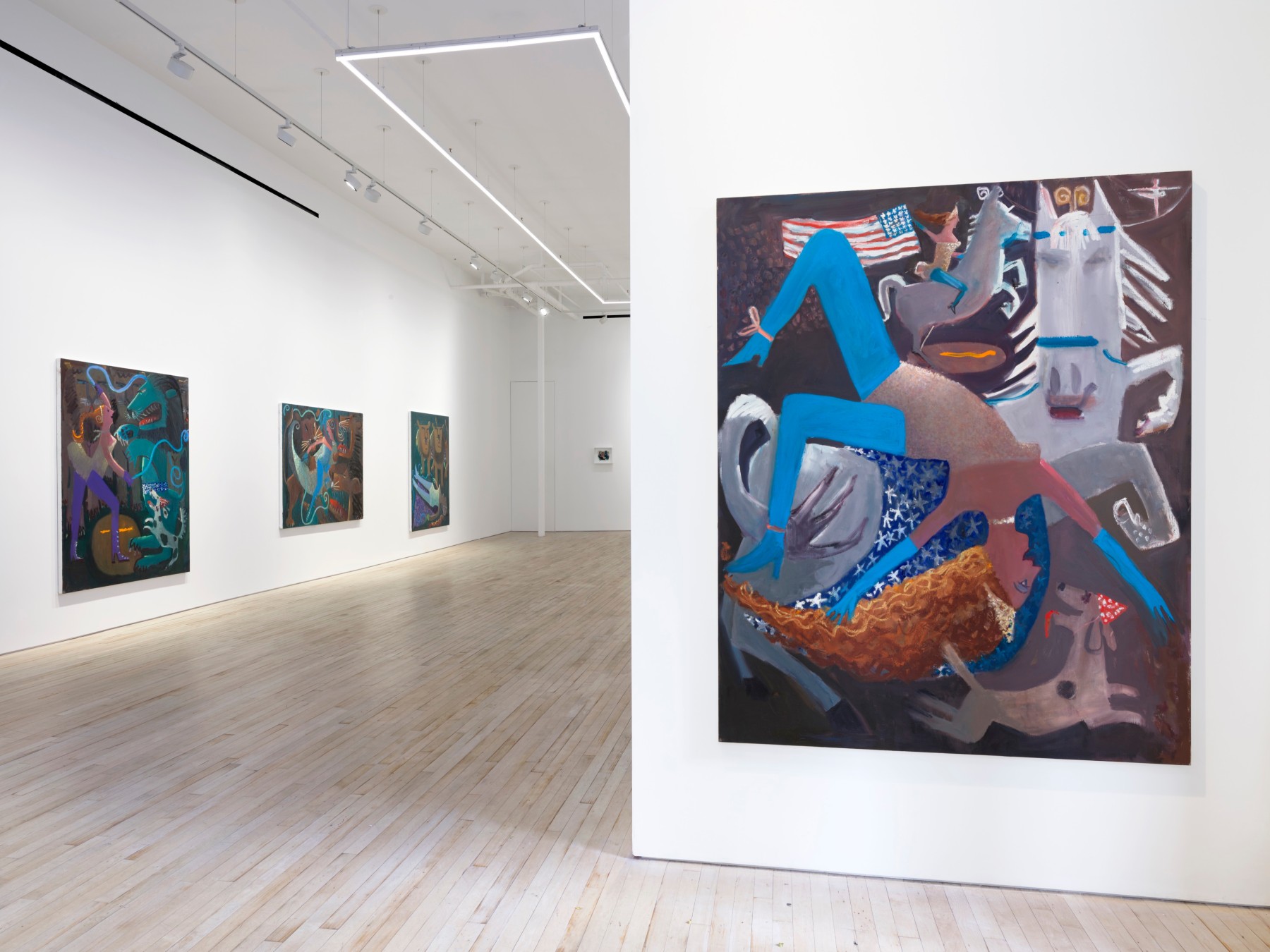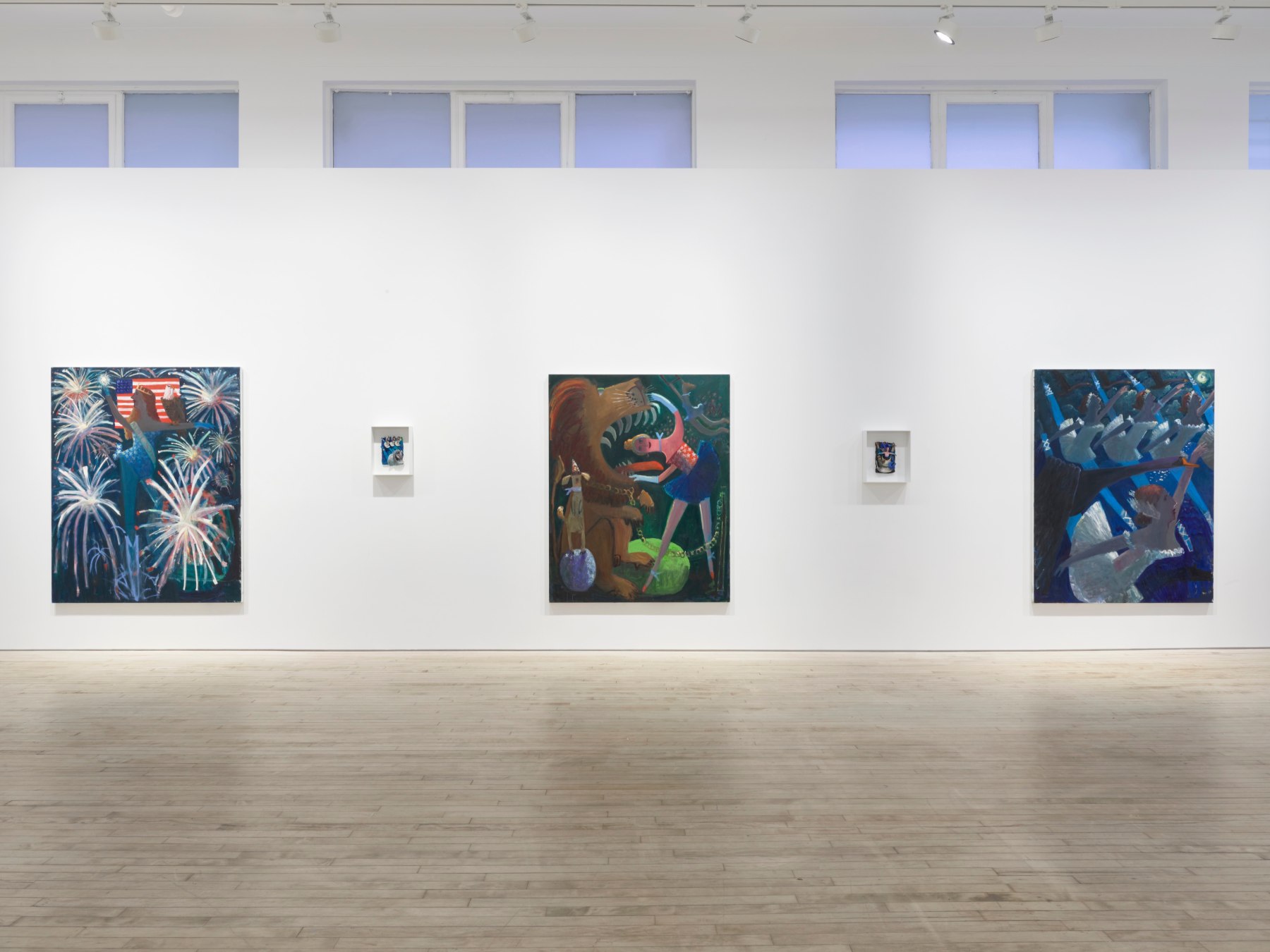Exhibition
The Greatest Show on Earth

INSTALLATION VIEW “The Greatest Show on Earth”, 2025. Courtesy of the Artist and Nino Mier Gallery.
Nino Mier Gallery is pleased to present Kyle Staver’s third solo exhibition with the gallery titled, The Greatest Show on Earth, opening November 7th at our Tribeca location. The Greatest Show on Earth premiers new paintings and clay reliefs which reference the historical identity of the circus. An essay by Jennifer Samet titled Perpetual Motion: Kyle Staver’s Circus Paintings was commissioned on the occasion of the exhibition.
Kyle Staver doesn’t believe in stillness. Her paintings move and breathe, heave and pulse, thrust and spin us around like the trapeze artists they depict. Staver now proudly defines herself as a storyteller – an artistic identity that was discouraged in the formalist art world of her younger adult years, and at Yale, where she studied in the 1980s. Her subject matter has evolved from depictions of personal familial lore and everyday life, into fairy tales and Greek mythology. Staver was in search of universally understood stories, rather than subjective ones, so that she and the viewer could “hold hands” in mutual recognition. She brought a feminist correction to these myths, presenting the women as strong heroines with agency over their situations. For example, she often re-contextualizes stories of rape and abduction that dominate the Western art historical canon – Europa and the Bull, Leda and the Swan – as consensual, safe love affairs. However, Staver has recently turned her gaze from Greek goddesses to mighty American women. The circus as subject was the answer.
In telling her stories, Staver has never been interested in a frozen moment. She doesn’t look to Piero della Francesca, Poussin, or Balthus. Instead, her pantheon includes Courbet, Rembrandt, and Renoir. The lion tamers, acrobats, dancers, and equestrians she depicts arc around the canvas with upended legs, twirling scarves and flying tutus. She directs our eyes and attention to dart and dance along with the performers through brilliant accents of light, dynamic color, and echoing, rhyming curves and patterns like zebras’ stripes, lion’s teeth, and bursting fireworks.
Another form that repeats through this new body of work is the American flag. What can we make of utilizing this symbol in our current moment? The flag, and the bald eagle, have been co-opted in American politics, over the past decade, as indicators of far-Right Republicanism. In the 2024 election cycle, Democrats sought to reclaim “patriotism” to herald democratic ideals and freedoms. Perhaps Staver’s use of the flag is another way she re-frames stories through a more just lens.
Politics aside, the flag is another way of “holding hands” with the viewer: it is a decidedly recognizable visual form. These are American paintings, and they depict a form of entertainment that was broadly available across socioeconomic and geographic strata. It is a way to get back to her roots – “The Greatest Show on Earth” – the Americana of her Minnesota childhood. The circus, as we know it, is a uniquely American phenomenon, tied to Western expansion, the development of the railroad, and American imperialism. The circus was most viewers’ first encounter with exotic animals; lions, elephants, tigers, zebras were in turn connected with, and symbols of, European colonialism. These are power dynamics that Staver has perpetually undone and remade in her paintings, through humor, exuberance, and humanism.
Within Staver’s paintings, the flag becomes a microcosm of the patterns that echo throughout. The stars and stripes direct us through less familiar patterns, almost like they would a circus viewer of the early 20th century. Patterning by its very nature is about connection – repetition, similarity, echoing. In Staver’s paintings, patterns are ways of locating ourselves, and also traveling through the compositions. In Zebra’s Show, the insistent black stripes on the animals’ white bodies, both horizontal and vertical, create a grid across the canvas. They are echoed by the acrobats’ outstretched arms and legs, pointed in position, and the red and white stripes of the American flags blanketing the zebra’s backs. In Swan Lake, Staver closes in on a row of ballerinas, making the painting as much as much about the diagonal lines of the dancer’s legs. Their white leotards and skirts, in this tilted position, echo the shape of the swan in flight that crosses above them. Miss Minnesota places patterns of fireworks bursting all around a crowned pageant winner, who holds a torch in one hand while a bald eagle perches on her opposite arm, toes pointed in cowboy boots.
There’s an unabashed exuberance in Staver’s paintings that is connected to the subject matter while simultaneously transcending it. In her world, Americanism isn’t about isolationist nationalism, but the acceptance of freaks and weirdos. And, of course, the women are powerful and unafraid. In Ring of Fire, the lion tamer faces her charge head-on. Her blue leotard sparkles with crystals and rhinestones, especially at its shelf-like bodice. Her reddish ponytail flashes behind her, along with the puff ball on the back-side of her costume. While she is three-dimensional, the lion’s massive head is flattened. His teeth curve inwards, his whiskers become a star form, and eyes are narrow white rectangles with squarish, glowing green pupils. The lion has seemingly been broken down by geometry and turns the painting into a comically fantastic image. This form of humor – the absurdity and vulnerability that characterizes our everyday lives – is a throughline in Staver’s work; itself taming brutal subject matter, and shining its light instead on empathetic humanism. The paintings’ insistence on movement is a form of optimism – a reminder that change, and reimagination, is a constant.
Kyle Staver (b. Virginia, MN, US; lives and works in New York, NY, US) earned her BFA from Minneapolis College of Art and Design and her MFA from Yale University. In 2015, she was awarded the John Simon Guggenheim Memorial Foundation Fellowship and the American Academy of Arts and Letters Purchase Prize, and in 2003, she was awarded the Louis Comfort Tiffany Foundation Award. She has had solo exhibitions at Nino Mier Gallery, Brussels; Half Gallery, New York; Zürcher Gallery, New York; Galerie RX, Paris; Steven Harvey Fine Art Projects, New York; among many others. Her work is in the collections of the National Academy of Design (New York), The American Academy of Arts and Letters (New York), The National Arts Club (New York), The McEvoy Foundation (San Francisco), and Portland Community College (Portland, Oregon). Staver is also recognized as a distinguished member of the National Academy of New York.
Jennifer Samet has interviewed over 100 artists – including Kyle Staver – for her column “Beer with a Painter,” in Hyperallergic. She recently published the introduction to Women Artists in Their Own Words, and a chapter on contemporary art for FAMM (Female Artists of the Mougins Museum), Both Merrell Publishers, 2025. Recent curatorial projects include “The Feminine in Abstract Painting,” Milton Resnick and Pat Passlof Foundation; and “Godzilla: Echoes from the 1990s Asian American Arts Network,” Eric Firestone Gallery. She is Senior Director of Eric Firestone Gallery and faculty at the New York Studio School.

INSTALLATION VIEW “The Greatest Show on Earth”, 2025. Courtesy of the Artist and Nino Mier Gallery.

INSTALLATION VIEW “The Greatest Show on Earth”, 2025. Courtesy of the Artist and Nino Mier Gallery.
2025. 11. 07. (Fri) – 2025. 12. 16. (Tue)
Nino Mier Gallery (New York)